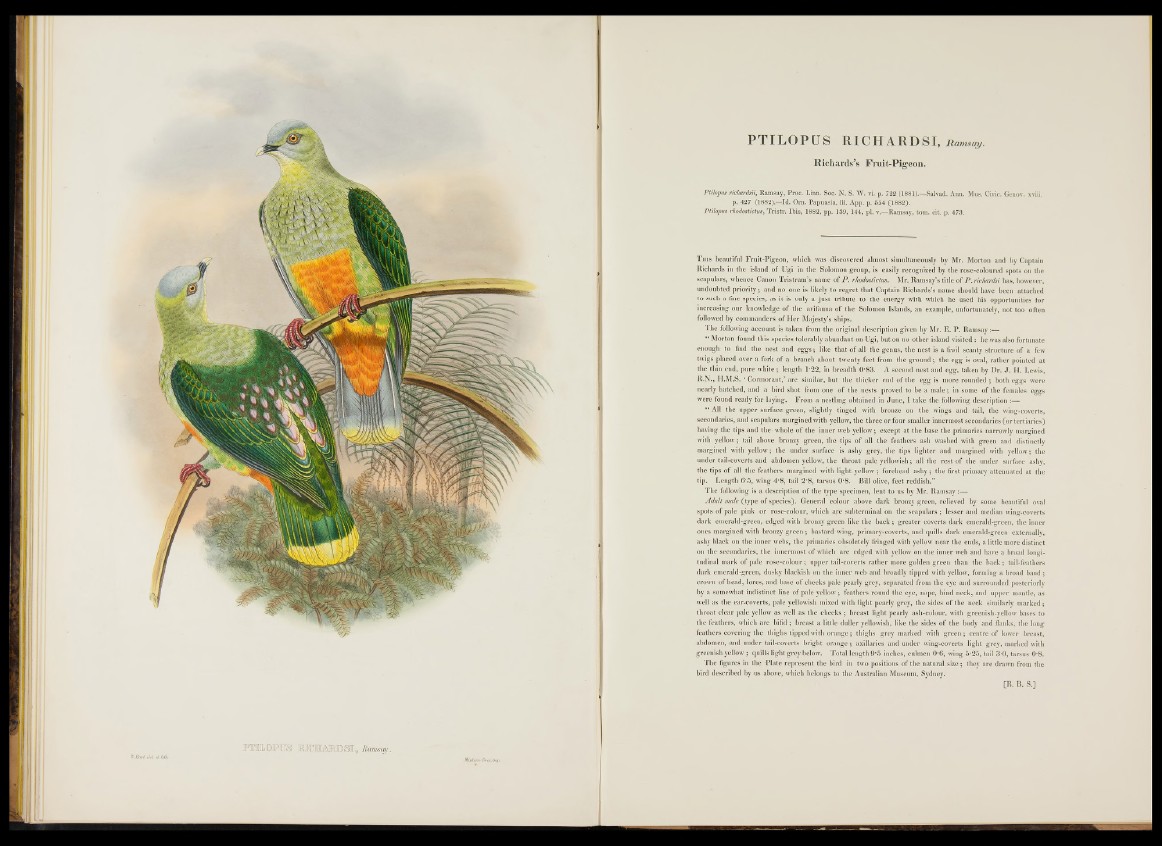
V.Uart del el Uflv.
PTILOPTO MKCMAMJD)SI9 Ramsay.
PTILOPUS RICHARDSI, Ramsay.
Richards’s Fruit-Pig*eon.
Ptilopus richardsii, Ramsay, Proc. Linn. Soc. N. S. W. vi. p. 722 (1881).—Salvad. Ann. Mus. Civic. Genov, xviii.
p. 427 (1882).—Id. Om. Papuasia, iii. App. p. 554 (1882).
Ptilopus rhodostictus, Tristr. Ibis, 1882, pp. 139, 144, pi. v.—Ramsay, tom. cit. p. 473.
T his beautiful Fruit-Pigeon, which was discovered almost simultaneously by Mr. Morton and by Captain
Richards in the island of Ugi in the Solomon group, is easily recognized by the rose-coloured spots on the
scapulars, whence Canon Tristram’s name of P. rhodostictus. Mr. Ramsay’s title of P . richardsi has, however,
undoubted p rio rity ; and no one is likely to regret th at Captain Richards’s name should have been attached
to such a fine species, as it is only a ju st tribute to the energy with which he used his opportunities for
increasing our knowledge o f the avifauna o f the Solomon Islands, an example, unfortunately, not too often
followed by commanders o f H e r Majesty’s ships.
The following account is taken from the original description given by Mr. E . P. Ramsay:—
“ Morton found this species tolerably abundant on U gi, but on no other island visited : he was also fortunate
enough to find the nest and e g g s ; like th at o f all the genus, the nest is a frail scanty structure o f a few
twigs placed over a fork o f a branch about twenty feet from the g ro u n d ; the egg is oval, rather pointed at
the thin end, pure white; length 1-22, in breadth 0 -83. A second nest and egg, taken by Dr. J . H. Lewis,
R.N., H.M.S. ‘ Cormorant,’ are similar, but the thicker end o f the egg is more rounded ; both eggs were
nearly hatched, and a bird shot from one o f the nests proved to be a male ; in some o f the females eggs
were found ready for laying. From a nestling obtained -in Ju n e, I take the following description :—
“ All the upper surface green, slightly tinged with bronze on the wings and tail, the wing-coverts,
secondaries, and scapulars margined with yellow, the three or four smaller innermost secondaries (o r tertiaries)
having the tips and the whole o f the inner web yellow; except a t the base the primaries narrowly margined
with yellow; tail above bronzy green, the tips o f all the feathers ash washed with green and distinctly
margined with yellow; the under surface is ashy grey, the tips lighter and margined with yellow; the
under tail-coverts and abdomen yellow, the throat pale yellowish; all the rest o f the under surface ashy,
the tips o f all the feathers margined with light yellow ; forehead a sh y ; the first primary attenuated at the
tip. Length 6'5 , wing 4*8, tail 2 ‘8, tarsus 0 ‘8. Bill olive, feet reddish.”
The following is a description o f the type specimen, lent to us by Mr. Ramsay :—
Adult male (type o f species). General colour above dark bronzy green, relieved by some beautiful oval
spots o f pale pink or rose-colour, which are subterminal on the scapulars ; lesser and median wing-coverts
dark emerald-green, edged with bronzy green like the b a c k ; greater coverts dark emerald-green, the inner
ones margined with bronzy g r e e n ; bastard wing, primary-coverts, and quills dark emerald-green externally,
ashy black on the inner webs, the primaries obsoletely fringed with yellow near the ends, a little m ore distinct
on the secondaries, the innermost o f which are edged with yellow on the inner web and have a broad longitudinal
mark o f pale rose-colour ; upper tail-coverts rather more golden greeii than the b a c k ; tail-feathers
dark emerald-green, dusky blackish on the inner web and broadly tipped with yellow, forming a broad band ;
crown o f head, lores, and base o f cheeks pale pearly grey, separated from the eye and surrounded posteriorly
by a somewhat indistinct line o f pale yellow ; feathers round the eye, nape, hind neck, and upper mantle, as
well as the ear-coverts, pale yellowish mixed with light pearly grey, the sides of the neck similarly marked;
throat clear pale yellow as well as the cheeks ; breast light pearly ash-colour, with greenish-yellow bases to
the feathers, which are bifid ; breast a little duller yellowish, like the sides o f the body and flanks, the long
feathers covering the thighs tipped with o ran g e ; thighs grey marked with g r e e n ; centre o f lower breast,
abdomen, and under tail-coverts bright orange ; axillaries and under wing-coverts light grey, marked with
greenish yellow ; quills light grey below. Total length 9*5 inches, culmen 0*6, wing 5-25, tail 3*0, tarsus 0-8.
The figures in the -Plate represent the bird in two positions o f the natural, s iz e ; they are drawn from the
bird described by us above, which belongs to the Australian Museum, Sydney.